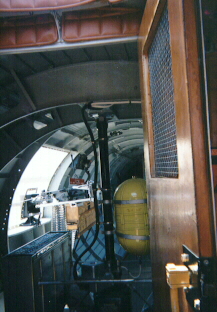Flying Fortress
Today, a child's wish is finally granted. The University of Houston's College of Engineering presents this series about the machines that make our civilization run, and the people whose ingenuity created them.
World War Two was the last time we felt sure who the bad guys and good guys were. I was eleven when Pearl Harbor was bombed. After that, I waited for the seemingly endless war to reach me. I wanted to be a pilot, so I studied airplanes and built models. I wanted to fly the Boeing B-17, the Flying Fortress. It was the best of the bombers with a range of 1800 miles and a wingspan near that of a Boeing 727. It went through seven models and many more jerry-built variations. By 1943, it was a superb airplane.
By 1951 I was an engineer working on the Boeing B-52. I never did learn to fly, and now I found myself helping to build a delivery system for the atom bomb. My dream had wandered off course.
Now, half a century later, all that comes back. I was a guest at Galveston's Lone Star Flight Museum Air Show this afternoon. Plane after plane flew by the stands -- stunt planes, war planes -- a small Pitts Special biplane did snap rolls and Immelmann turns, loops and barrel rolls. When it landed, out stepped 74-year-old Jack Vaught. Those hair-trigger reflexes belonged to a man older than any airplane here! As I chatted with Vaught, the captain of the B-17 hailed me. It was time to get on board.
I was to ride a B-17 at last. The captain had flown B-29s during the Korean War. I asked what it had felt like, going back to the old '17s. He said it felt much better. He put me in the radio operator's seat for takeoff. I was about to learn what he meant.
Smooth as glass, the plane left the runway while I listened to chatter in my earphones. The pilot of a vintage Japanese Zero overhead asked the show director if, just this once, he could get to shoot down the B-17 -- a little reminder that this ride might've been different in the dark days when I was only twelve.
The B-17 has a fine solidity. We make a tight turn, and I look straight down along the wing at the backs of three cows, 300 feet below. We make a bombing run over the airfield. Explosions are set off as we fly by. The enemy fighter attacks us, then turns on a smoke machine as he banks away. We've shot him down.
Small wonder. This B-17, Model G, has chin guns, machine guns on either side of the bombardier, a top turret, a belly turret, two waist guns, and a terribly vulnerable tail gunner (whose average lifetime in actual combat was something like 17 seconds.)
During the war, B-17s brought their crews back with two engines gone, with the rudder shot away, the nose blown off, the side laid open. As I threaded along the airplane's narrow catwalks this afternoon, my confidence in its sure movements had the validation of history.
So I finally flew my B-17. They say that youth is too fine a thing to waste on the young. Well, lucky for me, this experience was stolen from a child, and given instead -- to this old man.
I'm John Lienhard, at the University of Houston, where we're interested in the way inventive minds work.
(Theme music)
The Lone Star Flight Museum's Air Show was held at Sholes Municipal Field, Galveston, TX, on Saturday and Sunday, May 3-4, 1997.
I'm grateful to Ralph Royce, President of the Lone Star Flight Museum, for arranging this flight for me on Saturday, May 3, 1997.

The Lone Star Air and Space Museum's B-17G
(Photo © John Lienhard)

Looking Back at a Waist Gun from the Navigator's Chair
(Photo © John Lienhard)